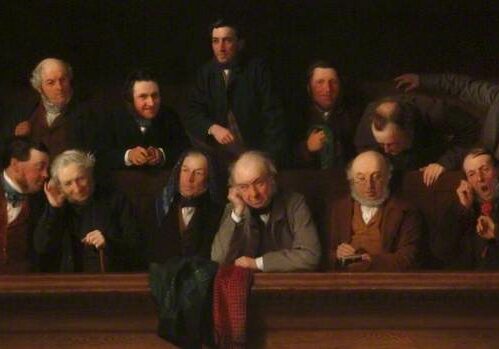Federal Habeas Corpus: Time Limits and the AEDPA
In my first column in a series on federal habeas corpus for state and federal prisoners, we’ll go over time limits for filing in federal court and how those time limits are calculated. The following information is adapted from my book WinningCites: Section 2255, A Handbook for Prisoners and Lawyers.
AEDPA and Affirmative Defenses
There is a one-year time limit to file a federal habeas corpus petition under 28 U.S.C. s. 2254 (for state prisoners) or a motion under 28 U.S.C. s. 2255 (for federal prisoners). Thanks to the Antiterrorism and Effective Death Penalty Act (“AEDPA”) signed into law on April 24, 1996, this time limit applies to prisoners filing for habeas relief in federal court. Don’t let the words “antiterrorism” and “death penalty” confuse you — Congress meant the harsh one-year restriction to apply to /i all /i prisoners. Today, courts have gotten away from the highly political aspect of the AEDPA speeding up the death penalty and stopping terrorism, and now say that the AEDPA’s purpose is to promote “finality” of convictions and sentences.
The time limit, however, is not an absolute bar. Instead, it’s an “affirmative defense” that the government (a general term for the federal or state prosecutor) can ignore or purposely waive. As an affirmative defense, it’s the government’s job to address whether your habeas petition or motion was filed on time. You don’t have to argue up front that your motion is on-time. But in reality, if your filing is late the government will surely raise such an easy defense. Even if it doesn’t, the court itself can raise it — if it gives you the chance to argue why your filing isn’t late. So, be ready. The only time the court cannot raise timeliness is if the government expressly waives it. Wood v. Milyard, 132 S. Ct. 1826 (2012); Day v. McDonough, 547 U.S. 198 (2006).
Calculating the One-Year Limit
The one-year AEDPA time limit applies to first-in-time motions and petition filed in the district court, as well as second or successive (“SOS”) applications filed in the court of appeals. Dodd v. U.S., 545 U.S. 353 (2005). There are four events that start the AEDPA clock. These aren’t merely “tolling” provisions that put the clock on hold. Rather, these triggers /i restart /i the clock. You get a full year to file your motion or petition from the date of the event. “Tolling” is the court pausing the AEDPA clock for certain reasons unrelated to the four events provided by law (see below).
One thing to know is that being late even by one day can be fatal to your habeas petition or motion. U.S. v. Marcello, 212 F.3d 1005 (7th Cir. 2000) (“foreclosing litigants from brining their claim because they missed the filing deadline by one day may seem harsh, but courts have to draw the line somewhere”). Being /i pro se /i (without a lawyer) doesn’t excuse you from following the time limits.
Typically, the one-year clock expires on the anniversary date of the event triggering the clock. Say your judgment became “final” on September 25, 2020, your one-year window under the first provision (noted below) would expire on September 26, 2021. Under Federal Rule of Civil Procedure 6(a), you don’t count the first day of the event (the day judgment was entered), and since September 26, 2021, is a Sunday, your deadline bumps up to September 30, the next business day, under Rule 6.
If you’re filing pro se from prison, your petition or motion is considered “filed” and the clock stops when you hand your papers to prison staff for mailing. This is called the “prison mailbox rule,” recognized by the Supreme Court in Hill v. Lockhart, 487 U.S. 266 (1988).
The general consensus is that a court may not extend the time to file your habeas petition or motion. You have to file something to give the court authority to grant an extension, such as the application stating your claims (you can file a memorandum in support of the claims later without penalty). The reasoning is that because a habeas case is a new “independent civil suit,” the court doesn’t have a “case or controversy” giving it jurisdiction to extend the time until something is filed to open the case. See Swichkow v. U.S., 565 Fed. Appx. 840 (11th Cir. 2014); but see U.S. v. Thomas, 713 F.3d 165 (3d Cir. 2013).
One Year from Judgment Becoming Final
The first trigger that starts the AEDPA clock is the date on which your judgment becomes final. [Federal prisoners: s. 2255(f)(1); state prisoners: s. 2244(d)(1)(A)] You get one year from that date. This is by far the most common deadline prisoners face in habeas cases. Nearly all ineffective assistance of counsel (“IAC”) claims, the most common habeas claims, would fall under this first trigger for the AEDPA clock.
But when is a judgment “final?” In Gonzalez v. Thaler, the Supreme Court settled the question and held that a judgment is final when all options to appeal have expired or all appeals have been denied. 132 S. Ct. 641 (2012). This is true even if you waived your right to appeal in a plea agreement, because you can still /i file /i an appeal even if it gets dismissed under the waiver.
One Year from the Date an Impediment is Removed
Under a more rare and less understood provision, you have one year to file from the date an unconstitutional “impediment” put in place by the government is removed. [Federal prisoners: s. 2255(f)(2); state prisoners: s. 2244(d)(1)(B)] There are two requirements to meet this starting point. First, the impediment must be a true obstacle and not merely something making it more difficult to file your petition or motion. Second, the obstacle must be unconstitutional or unlawful under federal standards.
For example, say the government withholds favorable evidence from you in violation of Brady v. Maryland, 373 U.S. 83 (1963), which held that this is a violation of the U.S. Constitution’s Due Process Clause. Some courts have held that the date you discover that this evidence was withheld, the clock restarts under this second provision. See U.S. v. Cottage, 307 F.3d 494 (6th Cir. 2002). Brady claims have also been recognized under the fourth provision noted below. Asserting both provisions may be a good idea.
One Year From a Retroactive Supreme Court Decision
The third provision allows the AEDPA clock to restart from the date of a retroactive Supreme Court decision. [Federal prisoners: s. 2255(f)(3); state prisoners s. 2244(d)(1)(C)] What’s interesting is that /i any /i court can make a Supreme Court decision retroactive for this provision, and it doesn’t have to be the Supreme Court itself — unlike the requirement for filing a SOS petition or motion, which does say that the Supreme Court must make its decision retroactive (which rarely ever happens).
It’s also different from the SOS realm because the high court’s ruling doesn’t have to be a constitutional decision. This means a Supreme Court decision interpreting a statute applies retroactively under this provision because statutory interpretation cases /i always /i apply retroactively, since the Court’s interpretation is what the statute is what the law has always meant. U.S. v. Peter, 310 F.3d 709 (11th Cir. 2002).
One Year From the Date of Newly Discovered Facts
The fourth provision restarting the one-year clock is “the date on which the facts supporting the claim or claims presented /i could have been /i discovered through the exercise of due diligence.” [Federal prisoners: s. 2255(f)(4); state prisoners: s. 2244(d)(1)(D)] The provision for state prisoners may seem similar and courts regularly conflate the two provisions, the slightly different language matters.
State prisoners must show discovery of the “factual predicate” for the claim. Federal prisoners only have to show discovery of “facts supporting the claim.” A “predicate” is the basis for a claim, meaning the claim didn’t exist before the discovery. But the claim could have existed for federal prisoners, yet the clock doesn’t start until the facts are discovered to support the claim. It may seem like a minor difference, but when Congress uses different language for similar statutes, the Supreme Court says this is important. Duncan v. Walker, 533 U.S. 167 (2001).
Both federal and state prisoners must show due diligence. This doesn’t mean “maximum feasible diligence,” but only “reasonable diligence.” Holland v. Florida, 560 U.S. 631 (2010). In other words, you don’t have to exhaust every avenue to meet this standard.
The Supreme Court’s instructive case on this fourth provision is Johnson v. U.S., 544 U.S. 295 (2005), where the Court recognized a vacated prior conviction as a new “fact” to restart the AEDPA clock.
Equitable tolling and Exceptions to AEDPA
When none of the provisions can apply because your petition or motion is filed beyond these time limits, a court may allow “equitable tolling” of the one-year clock if (1) you’ve been pursuing your rights diligently, and (2) “some extraordinary circumstance” stood in your way and prevented timely filing. Holland, supra.
A good example of equitable tolling applied in a habeas case was Socha v. Boughton, 763 F.3d 674 (7th Cir. 2014). There, a public defender refused to turn over a prisoner’s case file so that he could file a habeas petition in federal court. The court rejected the government’s argument that the prisoner should have pieced together a petition even without the case file in order to meet the one-year deadline. The court said that this would result in courts rejecting numerous petitions for being inadequate. “Sometimes it takes longer to review the possibilities, discard the least promising, and write a concise pleading than it would to write a kitchen-sink petition,” the court said.
Also note that tolling applies under s. 2244(d)(2) while your state postconviction case is pending before you file your federal petition. This is a different tolling and you don’t have to show the Holland criteria; tolling is automatic as long as your case if pending in state court (including any appeals).
There are also /i exceptions /i to the AEDPA’s time limit. the Supreme Court addressed one such exception in McQuiggin v. Perkins, 133 S. Ct. 1924 (2013), holding that actual innocence is an “exception” to the AEDPA’s time limit. The Court reasoned that habeas corpus is designed to prevent a miscarriage of justice, an example of which would be imprisoning someone who is innocent. The AEDPA should not bar such a person from habeas relief, the Court said.
Conclusion
Filing your habeas petition or s. 2255 motion on time is critical. This information is just an overview of some deeper issues and I urge you to fully research the provision that applies to your filing. To give you an idea of the depth, my book has over 900 footnotes citing cases and other authority explaining these issues. In my next column, we’ll go over retroactivity of Supreme Court decisions for habeas corpus relief.
Recommended for you
Ex Parte Communications By Judge With Jury Required Reversal Of Convictions
At Martin Bradley III’s trial for racketeering, mail fraud, wire fraud, and money laundering, the district court had two ex parte communications with the jury. Bradley’s defense lawyers did not become aware of notes until after his appeal. Bradley filed a 2255 motion arguing, in addition to other things, that the court had violated Rule…
Drug Treatment And Vocational Training Improper Sentencing Considerations
Christopher Thornton moved for a downward variance at sentencing arguing, among other things, that “in-prison treatment during the proposed thirty-eight months would help mitigate any potential risk he posed to the community.” The district court denied the motion, but in doing so said that Thornton had “mental-health issues, and he needs drug treatment” and that…
Amendment 782 Motion Reconsideration
Reinaldo Rivera moved for 18 U.S.C. § 3582(c)(2) relief based on Amendment 782 to the Guidelines, commonly known as “drugs minus 2.” The district court granted the motion and reduced his sentence to 420 months from LIFE. But in doing so, the district court believed Rivera’s mandatory minimum was 30 years for his CCE conviction.…




